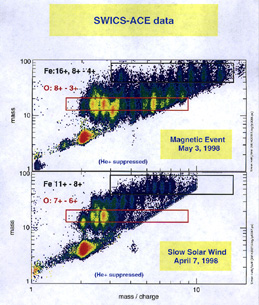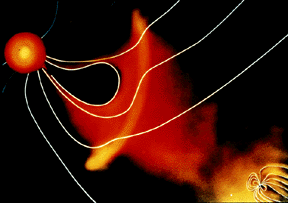Click on image for full size
Image courtesy of ACE-SWICS
ACE Satellite Probes Solar Event
News story originally written on June 8, 1998
During the last months increasing solar activity has resulted in a higher occurence rate of Coronal Mass Ejections (CMEs) than usual. In fact, one such event was recorded by SOHO on June 2, 1998. Another CME was recorded by the ACE spacecraft on May 3, 1998. SOHO observed a dramatic ejection of solar gas on the southwest limb of the Sun. The ACE satellite measurements have shown that the composition of these CMEs exhibits surprising patterns.These explosion events, first discovered in the 1970's, originate at the Sun's visible surface, the photosphere, and travel upward through its atmosphere, and then into its super-hot corona before speeding out into space, sometimes towards Earth. Before this May 3rd CME hit the Earth, the CME material passed the ACE satellite. On this occasion, the SWICS (Solar Wind Ionic Charge Spectrometer) instrument did not measure one homogeneous mass of material as the CME passed ACE. Instead, it was found that the CME consisted of an extremely hot region, followed by a cooler region and then another hot region of solar material. Further analysis is being done, but this discovery could change what scientists know about CMEs and about how CMEs affect the Earth's environment.
The ACE spacecraft will continue to track the solar wind coming from the Sun while solar activity increases. The ACE satellite serves as a spaceweather station while in orbit. The location of ACE enables it to provide about one-hour advance warning of any major geomagnetic activity that can cause aurorae or power losses here on Earth.
As we near solar maximum, more and more CMEs are likely to occur.















